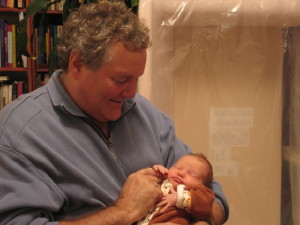
Doug is the director of the computer music center -- whatever they call it now -- at Brooklyn College. Maja is a mind-bogglingly talented violinist. Doug had composed a new piece for her, Innana's Descent, and it was chosen for inclusion on the 2012 SEAMUS CD. He wrote me asking about contemporary studio production techniques ("hey, how come snazzy popular music sounds so good?"), and since Doug and Maja only live a few blocks away from our NY apartment, we made arrangements to meet and talk about fun audio stuff.
One of the things I find interesting about 'classical' recording vs. 'popular' recording is the still-extant notion that somehow a recording of a 'classical' piece has to function as a simulacrum of a live performance. In contrast, a 'popular' piece uses the recording studio almost as a standalone instrument, with the intended object-result the playback through speakers. Hearing a straight-ahead solo violin sound, especially a virtuosic one, sets an expectation of a 'classical' audio representation. Doug's pursuit of a snazzable, speaker-playback-oriented sound for his 'classical' piece would be difficult.
I thought it might be fun for me to take a crack at deconstructing the recording of Maja's performance to see how far I could push a signal-processing approach to re-composing Doug's piece. Bwah ha ha! My evil intention: "Yeah, yeah, Doug, just slide me over dat recawding youse made o' Maja, dat's da ticket!" -- and Doug fell for it!
the Majas is the result of my going berserk with DSP software. It sounds nothing like Doug's piece, for I generally used only small fragments from the original recording. All of the sounds (except for the "environment" recording in Maja-J) are the result of signal-processing operations on Maja's violin sound. In Maja-Q I indulged my passion for massive amounts of reverb. Hey, it was a demo to Doug of DSP, so why not? I reverbed the violin! Then I reverbed the reverb! I added some echo and delay, and then I ran all of it through EVEN MORE reverb!
Maja-L served to let me mess around with total warp-dom of the violin and stashing the resulting sound fragments in a software sampler. I overdosed on reverb in Maja-Q, so most of the sounds in Maja-L are very "dry". Maja-J was something I thought would be fun to do: I put Maja into a pre-recorded context, operating as a 'magical-realist' fiddler on the threshold of perception in the sound of an Actual Place. The primary environmental recording for this piece was made at Akira Takaoka's (also a very close friend) cabin in Nagano Prefecture, Japan. I think I made the recording in the early 1990's, so that suggests that the voices heard in the background are probably a very young Lian and Jill, or possibly Akira's wife Christianne. However, it may be a recording from later, and the voices might be Daniel and/or Johannes (Akira and Christiane's son).
So here they are, quiet, loud and "Japanese" Maja. Thanks Doug!
Thanks Maja!
